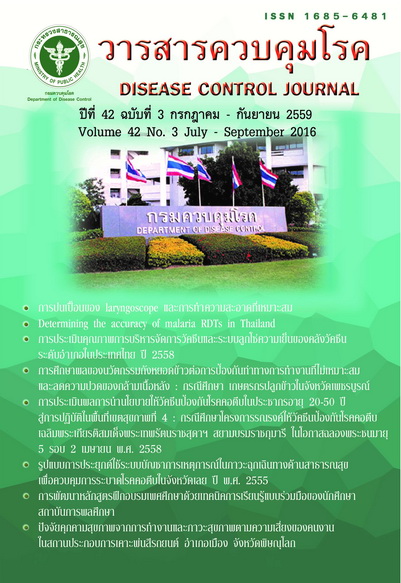The application incident command system in public health emergencies model to control diphtheria outbreak in Loei Province 2012
DOI:
https://doi.org/10.14456/dcj.2016.16Keywords:
incident command system, public health emergencies, outbreak, diphtheriaAbstract
The objective of this study was to evaluate the efficacy of an incident command system in controlling public health emergencies, specifically applied to a Diphtheria outbreak in Loei Province in 2012. The study was completed in 2 steps; step 1 was a quantitative study. To complete this, all patients and exposed diph¬theria cases who lived in Loei Province in 2012 were given an investigation report form from the Bureau of Epidemiology. The results were then used for a data analysis. The result showed that this diphtheria outbreak occurred from June to November 2012. Twenty seven confirmed cases and two deaths were found with a morbidity rate of 4.35 per 100,000 pop, a mortality rate of 0.32 per 100,000 pop, and a case fatality rate of 7.41 percent. The patients were distributed in four districts, 19 cases were observed at Dan sai, 5 in Wangsaphung, 2 in Phakao, and 1 in Phulaung. In the thirteen sub-districts, the highest number of patients were in the Songkhram sub-district of Wangsaphung, followed by the Kok Sathon and Ipum sub-districts of Dan Sai. Step 2 was a qualitative study. Study subjects were selected using a purposive sampling technique taken from doctors, nurses, health officers, SRRT officers and Village Health Volunteers (VHV) that were present in the diphtheria outbreak area. A survey was used in evaluating the guidelines on treating patients with suspected diphtheria. Immunization status using was also evaluated a data collection form created by the researchers. Results were then used for a data analysis. Results showed that this out break control model in¬cludes four components: (1) Primary prevention & communication (2) Investigation, Lab diagnosis, and surveillance (3) Clinical care and mop up (4) and Back up, and used 6 main measures includeing: (1) Synchronization command (2) investigation and diphtheria surveillance (3) care of patients and close contact cases and carriers (4) immunization (5) pharmaceutical preparations (6) and risk assessment communications. This model was divided in respect to the command system at all levels R10way, region, province and district.
Downloads
References
2. ธนวัน ชาแสงบง, สุรนอง ใหญ่สูงเนิน, สาธิต ศรีธรรมานุสาร, ธนเดช สัจจาวัฒนา, นัชชา พรหมพันใจ. การศึกษาระดับภูมิคุ้มกันโรคคอตีบของประชากรในพื้นที่สาธารณสุขเขต 5. วารสารวิชาการสำนักงานป้องกันควบคุมโรคที่ 5 นครราชสีมา 2547;10:12-8.
3. สำนักระบาดวิทยา กรมควบคุมโรค. คู่มือการดำเนินงานทางระบาดวิทยา. กรุงเทพมหานคร: โรงพิมพ์ องค์การรับส่งสินค้าและพัสดุภัณฑ์; 2542.
4. Cronbach L. J. Coefficient alpha and the internal structure of tests. Sychometrika 1951;16:297- 334.
5. Sieghart Dittmann, Melinda Wharton, Charles Vitek, Massimo Ciotti, Artur Galazka, Stephane Guichard, et al. Successful control of epidemic diphtheria in The States of the Former Union of Soviet Socialist Republics: Lessons learned. The Journal of Infectious Diseases 2000;181(Suppl 1):S10-22q.
6. Lumio J, Jahkola M, Vuento R, Haikala O, Es¬kola J. Diphtheria after a visit to Russia. Lancet 1993;342:53-4.
7. Markina SS, Maksimova NM, Bogatyureva AJ, Jilina NJ, Kotova EA. Update on diphtheria in Russia, 1992. In: Monisov AA, Podunova LG, Tyasto AS, Emeljanov OV, Churchill RE, editors. The health of the population and the environment. Moscow: Russian Federation State Committee on Sanitary Epidemiologic Surveillance; 1993. p. 3-8.
8. Expanded Program on Immunization, World Health Organization. Outbreak of diphtheria, update. Wkly Epidemiol Rec 1993;68:134-7.
9. Charles R Vitek, Melinda Wharton. Diphtheria in the Former Soviet Union: Reemergence of a pandemic disease. Emerging Infectious Diseases 1998;4:539-50.
10. Centers for Disease Control and Prevention. Up¬date: diphtheria epidemic-New Independent States of the Former Soviet Union, January 1995 - March 1996. MMWR
Morb Mortal Wkly Rep. 1996;45:693-7.
11. Dittmann S. Epidemic diphtheria in the Newly Independent States of the Former USSR - situation and lessons learned. Biologicals 1997;25:179-86.
12. Hardy I Dittmann S, Sutter R. Current situation and control strategies for resurgence of diphtheria in Newly Independent States of the Former Soviet Union. Lancet 1996;347:1739-44.
Downloads
Published
How to Cite
Issue
Section
License
Articles published in the Disease Control Journal are considered as academic work, research or analysis of the personal opinion of the authors, not the opinion of the Thailand Department of Disease Control or editorial team. The authors must be responsible for their articles.






